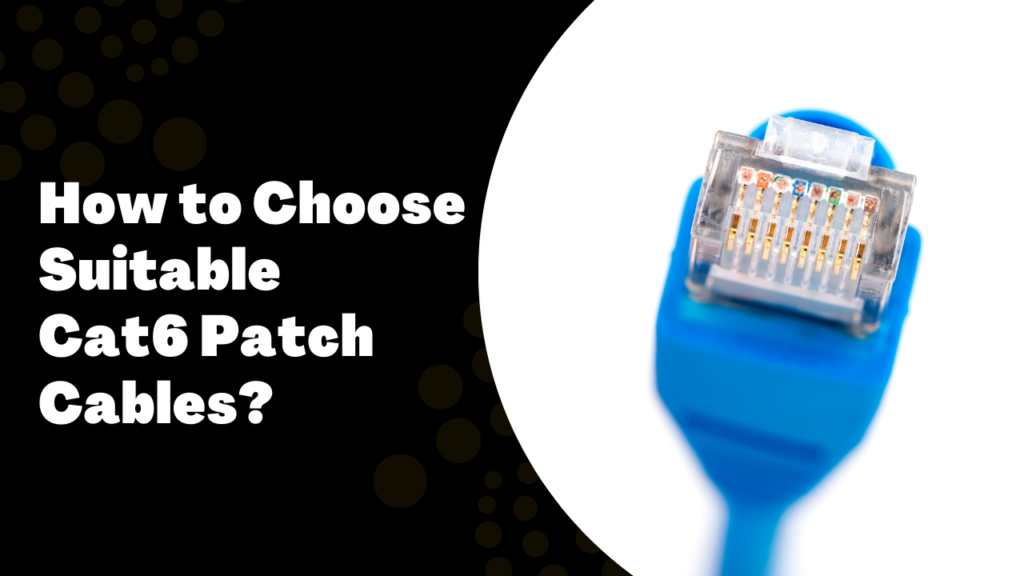How to Choose Suitable Cat6 Patch Cables?

Cat6 Ethernet patch cables are a must-have for all home and office networks. They are a reliable and user-friendly solution to connect different devices within a local area network (LAN). These cables come in a variety of shapes, sizes, and colors. And people are always wondering about how they can get cables that are best suited for their needs? And how can they tell the difference between a good patch cable and a bad one?
Cat6 cables can support data transfer rates of up to 1 Gbps over 100 meters and a bandwidth capacity of 550 MHz. If you are planning to get some good patch cords for your network, read on to learn about how to do it the right way.
Jacket
Let’s start from the outermost part of a patch cord. It is a cable jacket. There are three different types of cable jackets, namely, Plenum, Riser, and PVC. These jackets have different characteristics and they are used for their specific purposes.
For example, if you will be using your patch cord in an indoor space where air can flow freely, you will need to get a plenum-rated Cat6 Patch Cable. Because in open spaces, the risk of your cable catching fire is higher than in a closed space. The plenum-rated cable is specifically designed to prevent that from happening.
On the other hand, if you will be running your patch cable through an enclosed vertical space, such as a lift shaft or through a wall; you will be needing a riser-rated cat6 patch cord. In enclosed spaces where there is almost no airflow, the risks of fire hazards are very low. But even if the riser-rated cable does catch fire, the smoke emitted from it won’t affect you or anyone else in the building/space. Because the smoke will be contained within the enclosed space where the cable is installed.
For outdoor use, a PVC-rated cable can be used. This is the most basic cable jacket that you can get. But do not use it indoors. Because it can catch fire and also emit toxic smoke.
Colors
Patch cables with different colors are designed for different applications. The purpose of using cords with different colors is to make identifying the cables easier. They perform the same in all colors.
For example, grey ethernet patch cords are used for standard ethernet connections and yellow ones are used in power over ethernet (PoE) applications.
Depending on your requirement, you can choose the cables with the appropriate color.
- Yellow Patch cables are used in PoE applications.
- Black Patch cables are used for general purposes.
- White Patch cables are also used for general purposes.
- Green cables are for ethernet crossover applications.
- Blue Patch cables are used for communications servers.
- Gray patch cords are used for standard ethernet applications.
The color of the patch cord doesn’t matter for small-scale networks, such as a home LAN. Because you can identify which individual cord serves what purpose. Color codes of the cables are utilized in large-scale networks with a high density of cables.
Length
You should choose the length of your cat6 patch cord carefully. Because it can have a significant impact on its performance. If you run your cable at more than 50 meters of length, it can drastically decrease its data transmission speed.
The standard run length of ethernet cables is 50 meters or 164 feet. It is recommended that you do not run the cables at longer than this length. Otherwise, you will lose the efficiency of the cable to electromagnetic interference (EMI), crosstalk, and to resistance within the conductor wire.
Flexibility
Cat6 Patch Cables are pretty flexible these days and it’s not a major matter to be concerned about. However, if you want to be super cautious, the expert advice is to buy the bulk patch cables with a pure copper conductor. It has a more bend radius and can also withstand extreme temperatures.
Copper-clad aluminum conductors are more brittle and can snap in cold temperatures, but bare copper conductors can remain in perfect condition in the same environment.
Conductor and Shielding
Pure copper conductors are the best ones you can get. No matter what your networking requirements are, you should always go for bare copper conductors. They perform far better and also last far longer than any other.
However, you can choose between shielded or unshielded patch cables. Shielded Cat6 patch cords are the most suitable for you if:
- Your network has a high density of cables.
- You need the cables for outdoors.
- You need extreme performance.
If you can identify with one of the reasons mentioned above, you should definitely get shielded patch cables. They will perform smoothly in harsh outdoor conditions and in high cable densities.
Other than that, unshielded patch cords will provide perfect ethernet connections. Since Cat6 can already support fast data transmission and a high bandwidth capacity, you don’t really need to spend extra on a shielded cable.
Conclusion
Cat6 ethernet is the most widely used ethernet network. You can use this guide to buy the perfect Cat6 patch cables that are customized for your network. And enjoy seamless, high-speed network connections.






